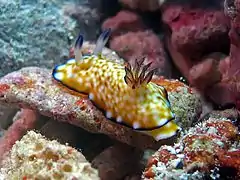Goniobranchus vibratus
Goniobranchus vibratus, common name trembling nudibranch, is a species of colourful sea slug, a dorid nudibranch, a marine gastropod mollusc in the family Chromodorididae.[2][3]
| Goniobranchus vibratus | |
|---|---|
 | |
| Scientific classification | |
| Domain: | Eukaryota |
| Kingdom: | Animalia |
| Phylum: | Mollusca |
| Class: | Gastropoda |
| Subclass: | Heterobranchia |
| Order: | Nudibranchia |
| Suborder: | Doridina |
| Superfamily: | Doridoidea |
| Family: | Chromodorididae |
| Genus: | Goniobranchus |
| Species: | G. vibratus |
| Binomial name | |
| Goniobranchus vibratus | |
| Synonyms[2] | |
| |
Etymology
The Latin species name vibratus derives from its habit of vibrating the gills rhythmically much like some species of Thorunna and Noumea.[4]
Distribution
This species was described from Hawaii. It has been reported in the Marshall Islands, in French Polynesia and in Japan, in the tropical Pacific Ocean.[4][5]
Habitat
These diurnal nudibranchs can be found exposed on subtidal reefs, rocky habitats and in tide pools or low intertidal, at depths of 1–24 m (3 ft 3 in – 78 ft 9 in).[5]
Description

The length of the body reaches 60–65 mm.[5] The basic body colour of these nudibranchs is bright yellow, with small white dots in relief. The margins of the mantle are bluish-purple, with large white pustules. The outline of the body is oblong or oval. Mantle is smooth and rounded. The thin margins do not conceal the foot behind. The seven brachial plumes are small, erect, ciliated and edged with violet. Dorsal tentacles are violet, short, ovate and lamellated. Foot is white and almost wide as the mantle.[5][6][7][8][9]
Biology
Goniobranchus vibratus feeds on encrusting sponges (Porifera, Phoriospongia poni or probably Chelonaplysilla violacea).[10] It lays a mass of eggs in a ribbon of 2-3 whorls. Hatching occurs in about 7 days.[5]
References
- Pease, William Harper. 1860. Descriptions of new species of Mollusca from the Sandwich Islands. Proceedings of the Zoological Society of London, pt. 28, pp. 18-36.
- Bouchet, P. (2012). Goniobranchus vibratus. Accessed through: World Register of Marine Species on 2012-05-08
- Johnson R.F. & Gosliner T.M. (2012) Traditional taxonomic groupings mask evolutionary history: A molecular phylogeny and new classification of the chromodorid nudibranchs. PLoS ONE 7(4): e33479
- Rudman, W.B., 2001 (January 8) Chromodoris vibrata (Pease, 1860). [In] Sea Slug Forum. Australian Museum, Sydney.
- Pittman, C. & Fiene, P., 2017. Goniobranchus vibratus Sea Slugs of Hawaii, accessed 2019-01-14.
- Rudman W.B. (1984) The Chromodorididae (Opisthobranchia: Mollusca) of the Indo-West Pacific: a review of the genera. Zoological Journal of the Linnean Society 81 (2/3): 115-273. page(s): 130
- Rudman W.B. (1986) The Chromodorididae (Ophistobranchia: Mollusca) of the Indo-West Pacific: the genus Glossodoris Ehrenbergh (= Casella, H. & A; Adams). Zoological Journal of the Linnean Society 86: 101-184. page(s): 166
- Debelius, H. & Kuiter, R.H. (2007) Nudibranchs of the world. ConchBooks, Frankfurt, 360 pp. ISBN 978-3-939767-06-0 page(s): 165
- Gosliner, T.M., Behrens, D.W. & Valdés, Á. (2008) Indo-Pacific Nudibranchs and seaslugs. A field guide to the world's most diverse fauna. Sea Challengers Natural History Books, Washington, 426 pp. page(s): 214
- Gary R. McDonald, James W. Nybakken, A List of the Worldwide Food Habits of Nudibranchs. University of California Santa Cruz.